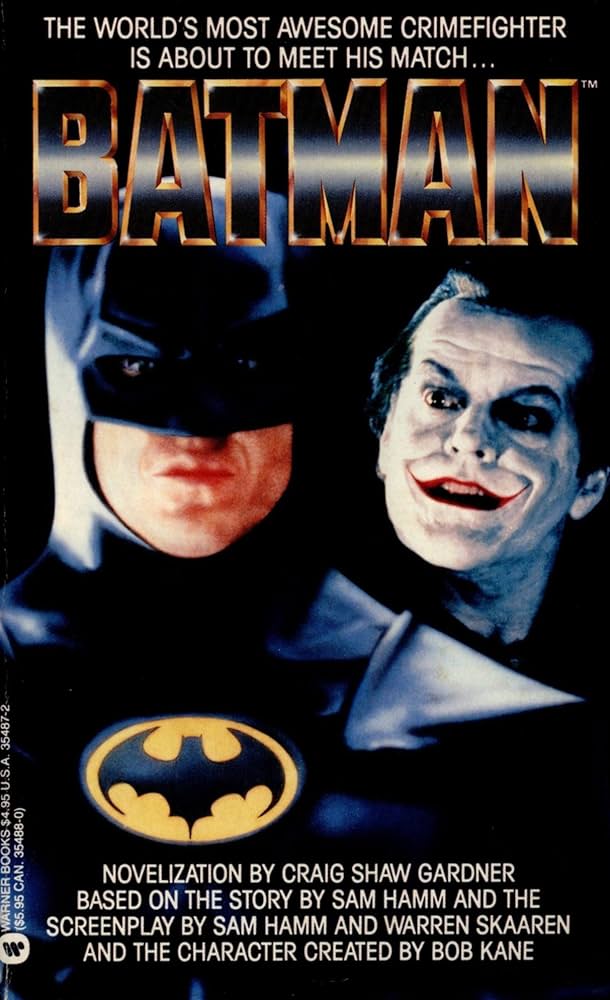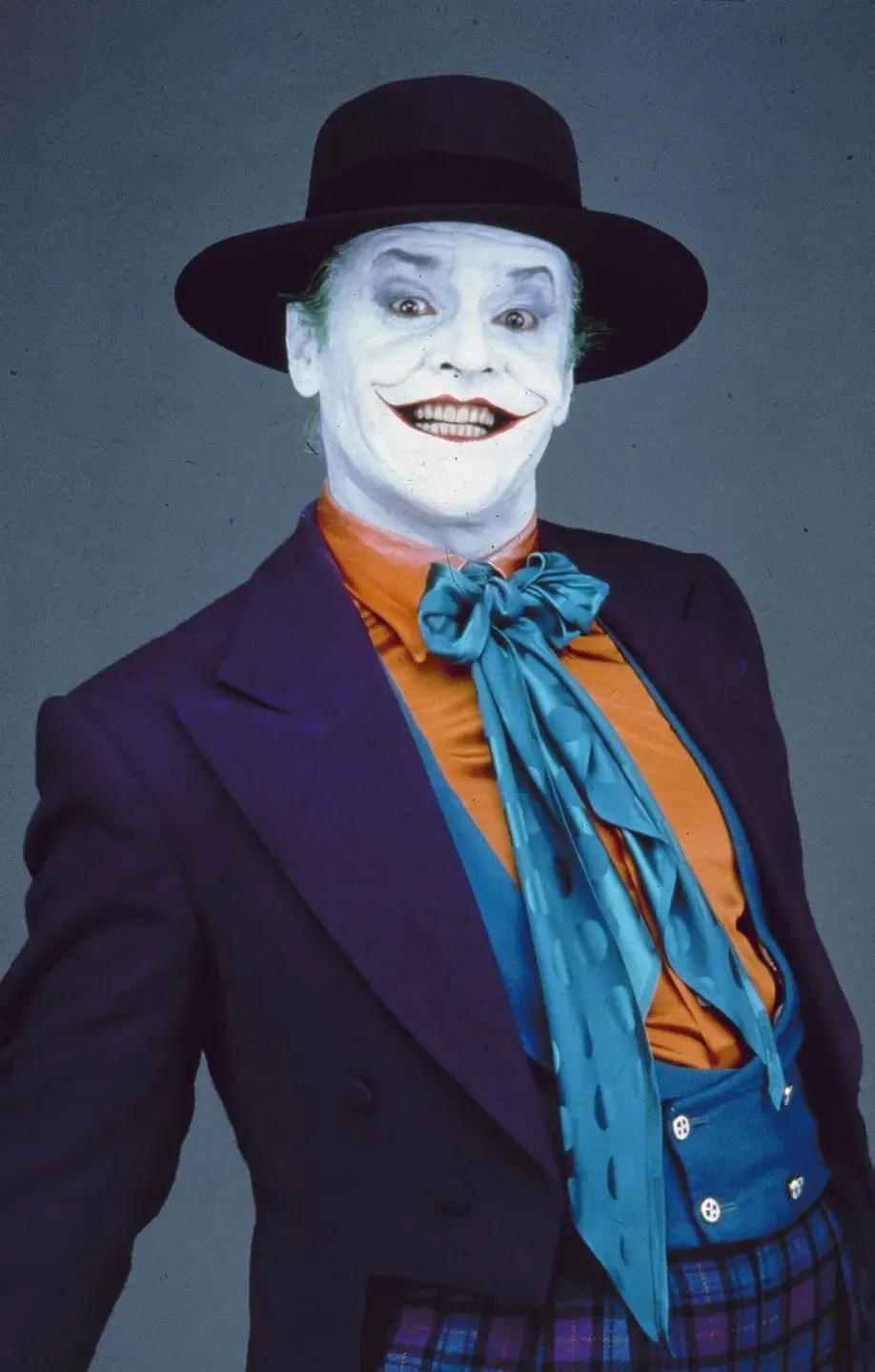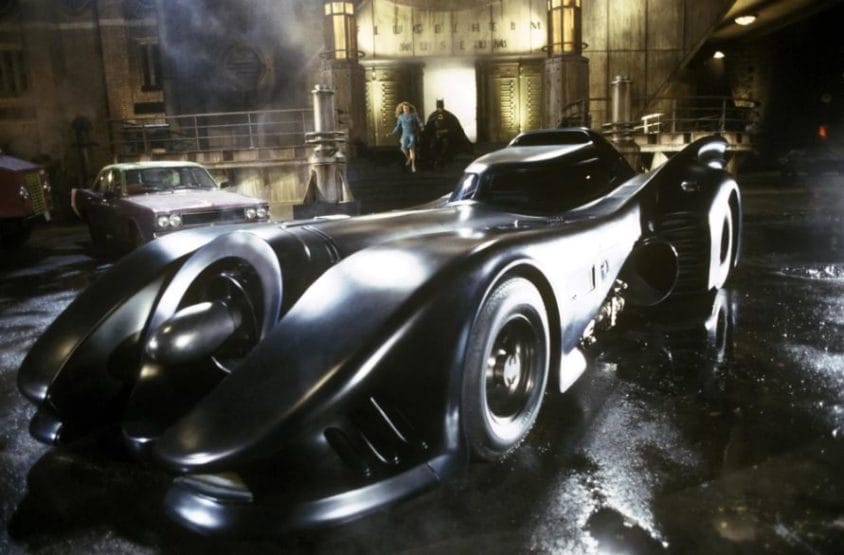Hollywood & Spine Archive: Bat Book
An overview of the novelization to BATMAN, originally published in June 2019.

Yes, Batman Returns may have let Tim Burton be a little bit more of a freak, but this is the comic book movie I probably like to throw on the most, like a comfy blanket. It's got a fun novelization that really threaded the needle on how to cover extremely well-known visual media in a non-visual medium. I love it! (originally published 6/20/2019)

Batman by Craig Shaw Gardner (based on the story by Sam Hamm and the screenplay by Sam Hamm and Warren Skaaren and the character created by Bob Kane [and Bill Finger]) (Warner Books, 1989)
The pitch: Gotham City's billionaire playboy Bruce Wayne takes his first steps as Batman and comes face-to-face with The Joker in this adaptation of Tim Burton's highly stylized and influential take on the DC Comics superhero.
The author: A notable fantasy writer throughout the '80s, '90s and '00s, Craig Shaw Gardner was also something of a steady hand in the novelization game. His adaptations include The Lost Boys and the Back to the Future sequels.
The lowdown: Tim Burton's iconic adaptation of Batman does something better than its few contemporaries (like 1978's Superman: The Movie) or, certainly, the dozens of films it inspired over the next three decades: it sets the scene and unveils the character quickly but effectively. The cowl-clad crimefighter descends upon two muggers on a Gotham rooftop, making short work of them before disappearing into the shadows almost as quickly as he appeared. Much like the character's first appearance in Detective Comics No. 27 some 80 years ago, it packs impactful, stylish, crucial narrative information into a brief series of images.
Images. From the newsstand to the TV screen, from pulp to camp to edgier fare, Batman stories live or die by their visuals...a trait that novelizations lack (save the occasional full-color photo insert). Considering just how bold the images of Burton's Batman remain - Anton Furst's Oscar-winning set design and Bob Ringwood's costume work still endure - you'd imagine Gardner's prose adaptation of the film would have its work cut out for it.

But from that first chapter, readers don't have to worry:
"Don't kill me," Nick whispered. "Don't kill me."
Nick opened his eyes. The bat stood out on the edge of the roof, and he held Nick out beyond the edge, over nothing.
The bat opened his mouth. His voice was a trap, like a file biting into steel.
"You're trespassing, rat-breath."
Nick looked down - six stories down, at the tiny, tiny cars so far below. He looked up into the bat's face, but where the thing's eyes should have been were two mirrors, twin reflections of Nick's fear.
Nick tried to ignore the pounding in his ears, the feeling of his legs kicking out at nothing but air. What did it matter? He was going to die anyway. He'd tell off the bat before he went.
"Trespassing?" He tried to laugh, but it came out as more of a cough. "You don't own the night."
The bat smiled.
"Tell your friends. Tell all your friends." The smile widened to show teeth. "I am the night."
Gardner's prose evokes all the visions of Batman that most fans hold dearest - the grim freedom fighter of the original comics, the brutality of Frank Miller's The Dark Knight Returns, the grounded realism of The Killing Joke - and translates them brilliantly into written word. (So brilliantly, in fact, that Gardner was not only asked to adapt the sequel Batman Returns but also penned a standalone, out-of-continuity novel, 1990's The Batman Murders.) But the author admitted years later that he wasn't flying blind when writing the Batman novelization.
"I was lucky enough to be able to visit the film set," Gardner told ComicsAlliance in 2014. "The baroque set design gave me a real idea of the mood of the film, which I tried to convey through my writing." He was not allowed to approach the cast or crew, but was "greeted with great enthusiasm by the technical and special effects crew," who allowed him to view the costume and props, including the Batmobile. (Gardner also revealed that a last-minute change to the film's ending required an equally last-minute pinch-hit for a few paragraphs by the comic's then-writer, Dennis O'Neil, who'd later write two novelizations for Christopher Nolan's takes (links) on the Caped Crusader.)

It's clear that this immersion into the physical world of Batman, combined with a faithful adaptation to the most unique aspects of Sam Hamm and Warren Skaaren's script, is a winning combination. More than any book we've covered on Hollywood & Spine so far, this is probably the smoothest transition from screen to page - a feat made all the more incredible when you consider the only time you're seeing the silhouette of the bat is when you close your eyes between page turns.
The cutting room floor: Deleted scenes and narrative deviations generally only occur in the back half of the novel, and nearly all were late cuts, based on their appearances in trading cards and comic adaptations. There are minor additions during the action sequence in the art museum, including two very unnecessary extended lines. (The Joker follows his classic quip "Where does he get those wonderful toys?" with "Don't just stand there - go and ask him!" Later on, Batman rescues a street urchin during the fight with The Joker's goons, who asks "Is it Halloween?")
There are other cosmetic changes here and there; some superfluous (the first instance of "You ever dance with the devil in the pale moonlight?" comes as a stray thought of The Joker's after murdering crime boss Carl Grissom), others informative (Gotham's bicentennial is postponed thanks to a Joker toxin slipped into the police department's coffee, explaining why the clown's parade goes on unchallenged), others just funny (after Batman bests his foe in the finale, reporters think they find The Caped Crusader's fallen body, only to uncover goofy newsman Alexander Knox unconscious beneath Batman's cape as a distraction). Another humorous aside: the deeply underrated songs in the film by Prince are merely represented as a repeated "Boomshakalakalaka"!

The biggest structural shift occurs in the second act, when The Joker invades Vicki Vale's apartment and attempts to take out Bruce Wayne. After shooting Bruce, Joker kidnaps Vale; Bruce recovers (his utility belt catches the bullet, not a serving tray), loyal butler Alfred arrives with a Batsuit, Batman gives chase on horseback(!), and hero and villain square off at a Gotham press conference, with the mayor and Commissioner Gordon looking on helplessly. Interestingly, this sequence originally took place at a circus, setting up the origin of Batman's sidekick Robin. That version never made it past the storyboard stage.
The last word: Batmania was undisputed 30 years ago - check here and here if you don't believe it - and it was enough to propel Gardner's book to the top of the New York Times bestseller list. Today, it's not hard to understand why: the book deftly, breezily captures the essence of the film in that forgotten grace period between seeing it on the big screen and waiting for the home video release.
